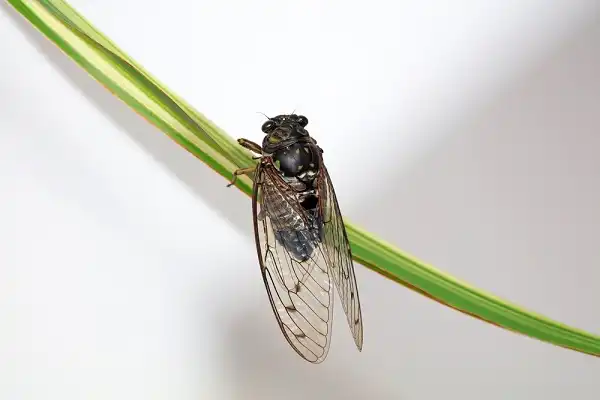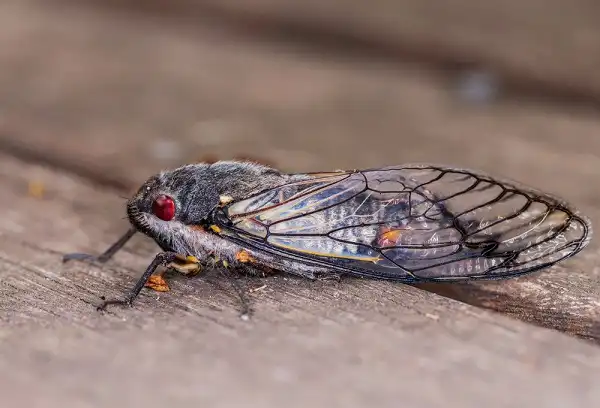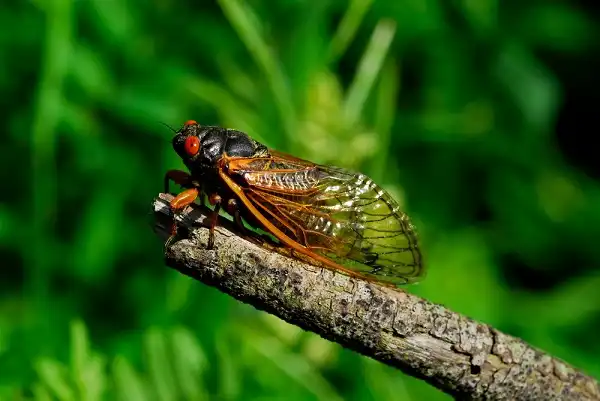Have you heard the buzz? The sound of cicadas erupting from the trees is a sign that summer has arrived! These hard-working insects have been around for millennia, and they play an important role in our environment. From their unique life cycles to their nocturnal singing, these fascinating creatures can tell us a lot about nature. Join me as I explore this interesting species – you’ll learn why cicadas are so special and discover some fun facts along the way!

Cicada Description
Cicadas are a type of insect that can be found all over the world. They have stout bodies and long, transparent wings that span up to 7 cm in length. Their colors range from green to brown and even yellowish-orange in some species. Depending on the species, they may have stripes or spots on their bodies or colorful bands along their wings. Cicadas are known for their loud buzzing sound, which is produced by the males to attract mates. The noise can reach up to 120 decibels, making it one of the loudest noises in nature! This sound is created when air passes through special membranes on the abdomen and vibrates at different frequencies.
Cicada Habitat
Cicadas are found in a variety of habitats, from lush woodlands to arid grasslands and even urban parks. They prefer warm climates and can thrive in temperatures up to 27 degrees Celsius. Depending on the species, cicadas may also inhabit deserts, marshlands, and other areas where there is an abundance of vegetation for them to feed on. Cicadas have adapted to many different types of environments, making them incredibly diverse creatures. For example, some species live exclusively in the rainforest while others live only on certain mountain ranges or islands. Some species are even found only in certain countries or regions! No matter where they call home, cicadas generally prefer living in warm climates with plenty of vegetation and moisture for them to feed upon.
Cicada Diet
Cicadas are primarily herbivores, feeding on the sap of trees, shrubs, and other plant material such as roots and stems. Adult cicadas feed on tree sap by inserting their long proboscis into the bark of trees or plant stems to drink the nutrient-rich liquid. They may also feed on other insects, including caterpillars, grasshoppers, and aphids. When in the larval stage, cicadas use specialized mouthparts known as “stylets” to feed on the sap of plant roots. This sap is rich in nutrients that help them grow throughout their life cycles. Although they don’t feed on leaves or flowers directly, adult cicadas can transmit pollen between flowers as they move from one area to another. In addition to plants and insects, some species of cicadas have been known to supplement their diet with fungi or other organic matter found in soil or decaying leaves. Depending on their species and habitat location, different types of cicadas may eat different things – making them even more diverse!

Cicada Size
Cicadas come in a variety of sizes depending on the species. Generally, adult cicadas range from 1 to 2 inches in length; however, some species can grow up to 7 cm long! They have stout bodies that are typically green, brown, or yellowish-orange in color and they have transparent wings that span up to 7 cm each. Their wings are usually adorned with colorful patterns and stripes, making them quite aesthetically pleasing creatures. The size difference between male and female cicadas is quite noticeable. Females tend to be slightly larger than males and have a wider abdomen due to their ovipositors – organs used for egg-laying.
Cicada Lifespan
The lifespan of cicadas varies greatly depending on the species, but in general, they live for a few weeks to several years. Cicada nymphs spend the majority of their lives underground in a dormant state, while adult cicadas usually live for around 4 to 6 weeks. Some species have life cycles that range from 5-13 years and are known as periodical cicadas. The longest-living species of cicada is Magicicada septendecim which has an average lifespan of 17 years. This species is found in parts of the eastern United States and has one of the most dramatic emergence patterns- large numbers appearing all at once after spending many years underground.
During their short lives as adults, these cicadas spend most of their energy singing and mate-searching before returning to the soil to lay eggs and begin the cycle anew. Cicadas have evolved many strategies for survival throughout their life cycles such as camouflage, defense mechanisms like noise or scent production, and even tricks such as self-amputation or casting off pieces of the wing to distract predators away from them. All these strategies help them survive longer to find mates and reproduce successfully – ensuring that future generations will be able to emerge once again!
Cicada Behavior
Cicada’s behavior is as unique and intriguing as its physical appearance. During the day, cicadas are active, flying around from tree to tree in search of mates and food. Males attract females by producing loud calls with their specialized organs called tymbals located on either side of their abdomens. The sound is produced by rapidly vibrating the tymbals at incredibly high frequencies and attracts females from far distances. In addition to calling for mates, cicadas also use an interesting defense mechanism called “self-amputation” which involves casting off pieces of their wings or legs to distract predators away from them. This trick works particularly well since it allows the cicada to escape without having to fight off its attacker – a clever adaptation that helps keep these creatures safe!

Cicada Speed
Cicadas are surprisingly fast fliers, capable of reaching speeds of up to 25 miles per hour when flying horizontally. When diving quickly to evade predators, cicadas can reach velocities of up to 50 miles per hour! This is impressive considering their small size and the fact that they don’t have any specialized airfoils like other insects such as dragonflies or bees. In addition to these fast flight speeds, cicadas are also incredibly agile and maneuverable in the air. They can make sharp turns, sudden stops, and instant accelerations without losing speed – allowing them to quickly escape from potential dangers. This agility is likely due to their long wingspan which helps them generate more lift when turning or changing direction.
Cicada Hunting
Cicada hunting is a popular hobby for many people, as cicadas are an interesting and often misunderstood insect. Cicadas can be hunted in several different ways, including hand-picking, using nets or traps, or even using audio lures to attract them. These methods have been used by cicada enthusiasts with varying degrees of success. Hand-picking is the most traditional way of hunting cicadas and involves patiently waiting near trees or other vegetation while keeping a keen eye out for the insects. Those experienced in this technique can usually identify cicadas easily by their size, coloration, and distinctive sound they make when flying. Once spotted, they must then be quick enough to catch them before they fly away! Using nets or traps also works well for catching cicadas as they are relatively slow fliers. Nets can be constructed from any lightweight material such as fabric or netting and should be placed near where the insects are likely to land such as trees or shrubs. Traps can also be created using large buckets filled with water and bait such as rotting fruit which will attract hungry cicadas looking for a snack.
Cicada Predators
Cicadas have many predators that pose a threat to their survival, such as birds, bats, small mammals, and even some species of reptiles. The most common predators of cicadas are birds, including woodpeckers, crows, blackbirds, sparrows, and jays. These birds often hunt in larger flocks and will quickly swoop down to capture unsuspecting cicadas in mid-air. Bats also prey on cicadas during the night hours by using their strong sense of echolocation to locate them. Small mammals such as squirrels and chipmunks also feed on cicadas but do so less frequently than their avian counterparts due to the larger size of their prey.

Conclusion
Cicadas are fascinating insects with an incredible array of adaptations that make them well-suited for life in the wild. From their impressive flying speed to their ability to create loud group choruses, cicadas display some truly remarkable behaviors which have enabled them to survive and thrive despite numerous predators. With the help of humans, these species can continue to persist in nature for many years to come!
Frequently Asked Question


